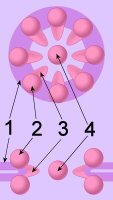Each nuclear pore (~125 mDa) is about thirty times the mass of a ribosome, and about 3000 to 4000 nuclear pores perforate the nuclear envelope of each cell. Nuclear pores permit diffusion of ions and small molecules, and mediate the selective transport of nuclear proteins, RNAs, and ribonucleoprotein (RNP) molecules by a signal-mediated, energy-dependent mechanism. Cells employ a short protein sequence called a 'nuclear localisation signal' to designate molecules for attachment of a nuclear import/export receptor or 'protein escort', permitting nucleocytoplasmic transport across the nuclear pore complex. These protein escort molecules or nuclear import/export receptors, are believed to be shuttled back and forth between the cytoplasm and nucleus.
 Nuclear pores are situated at junctions of the inner and outer membranes of the nuclear envelope (1). They contains 8 subunits that form a ring of subunits 15-20 nm in diameter (2). Each subunit projects a spoke-like unit (3) into the center of the pore, which looks like a wheel with 8 spokes. Inside each pore is a central plug or transporter (4).
Nuclear pores are situated at junctions of the inner and outer membranes of the nuclear envelope (1). They contains 8 subunits that form a ring of subunits 15-20 nm in diameter (2). Each subunit projects a spoke-like unit (3) into the center of the pore, which looks like a wheel with 8 spokes. Inside each pore is a central plug or transporter (4).1. nuclear membrane
2. outer ring
3. spokes
4. plug
When cells divide, nuclear pores, like the nuclear membrane, are disassembled. They are re-assembled after the cell division when the nuclear envelope is being rebuilt.
More information : detail : tem : em np : diagram npc : negative stain np : freeze-fracture np : subunits np
Џ beautiful Flash 8 animation - Inner Life of the Cell, which shows nuclear membrane with nuclear pore complexes, and Interpretation: Inner Life of the Cell Џ animation - spinning nucleus : art - nuclear membrane and nuclear pores : Virtual Cell Textbook - Cell Biology :
• A • adhesion • C • cell membranes • cellular adhesion molecules • cellular signal transduction • centrioles • chemotaxis • chloroplast • cilia & flagella • communication • concentration gradients • cytokine receptors • cytoplasm • cytoskeleton • E • energy transducers • endoplasmic reticulum • endosomes • exosome • F • flagella & cilia • G • Golgi apparatus • GPCRs • H • hormones • I • ion channels • L • lysosome • M • meiosis • microtubules • mitosis • mitochondrion • N • Nitric Oxide • neurotransmission • neuronal interconnections • nuclear membrane • nuclear pore • P • pinocytosis • proteasome • pumps • R • receptor proteins • receptor-mediated endocytosis • S • second messengers • signaling gradients • signal transduction • spindle • structure • T • transport • two-component systems • V • vacuole • vesicle •
No comments:
Post a Comment
Note: Only a member of this blog may post a comment.